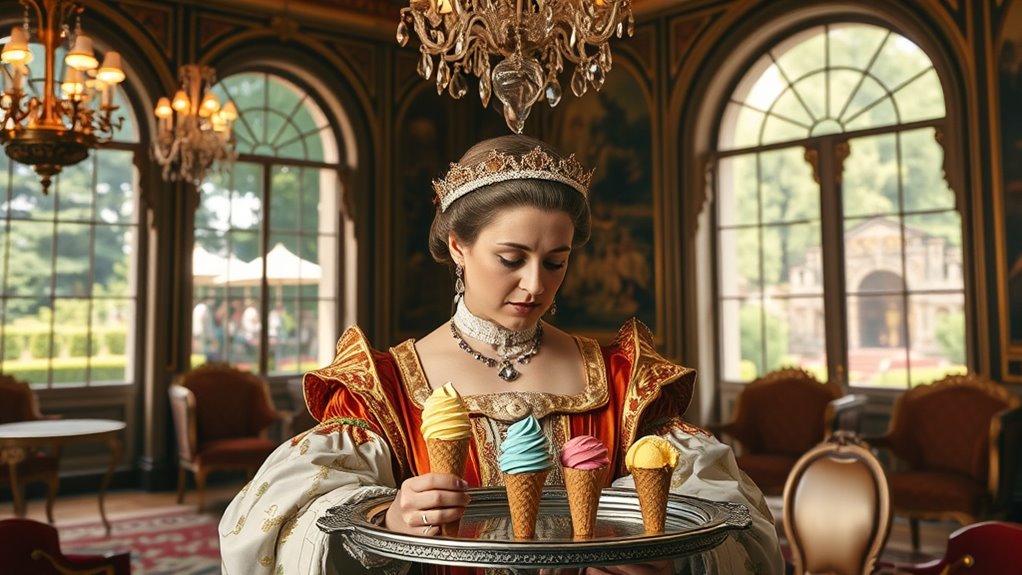When Catherine de’ Medici came to France, she brought her Italian culinary traditions, transforming French cuisine with innovations like ice cream. She used ice cream as a symbol of wealth and elegance, turning it into a luxury at court that showcased Italian sophistication. Her influence helped popularize frozen desserts, blending Italian artistry with French refinement. If you look further, you’ll uncover how her culinary diplomacy left a lasting mark on French gastronomy and culture.
Key Takeaways
- Catherine de’ Medici introduced Italian culinary traditions, including ice cream, to the French court, elevating its status.
- She used ice cream as a symbol of wealth and refinement in court festivities to showcase Italian elegance.
- Her patronage fostered French innovations in ice cream-making techniques, blending Italian and French culinary practices.
- Ice cream served as a diplomatic tool, enhancing cultural exchange and prestige among French aristocracy.
- Her influence transformed ice cream from a luxury item into a lasting emblem of cultural sophistication in France.

Catherine de’ Medici, the influential Italian-born queen of France, is often credited with introducing many culinary innovations to her adopted country, including ice cream. Her Medici influence played a pivotal role in shaping French cuisine, and her penchant for refinement helped elevate the culinary arts at the French court. By bringing recipes, techniques, and ingredients from Italy, she used culinary diplomacy as a strategic tool to forge alliances and display her cultural sophistication. When you consider her role in France’s gastronomic evolution, it becomes clear that her influence extended far beyond royal politics—it transformed how the French viewed and enjoyed their food.
Catherine de’ Medici revolutionized French cuisine through Italian culinary innovation and strategic cultural diplomacy.
Catherine’s background in Florence exposed her to the sophisticated Italian culinary traditions, which she sought to replicate and adapt at the French court. Her court became a hub of innovation, where new flavors and techniques were introduced through carefully curated banquets and gatherings. Ice cream, or “cream ice,” as it was then called, was among the luxurious delicacies that Catherine helped popularize. She recognized its potential not only as a dessert but also as a symbol of wealth and refinement. By integrating ice cream into court festivities, she subtly promoted Italian culinary practices, demonstrating her Medici influence and establishing a cultural bridge between Italy and France. This act of culinary diplomacy served to impress and win favor among the French aristocracy, showcasing her ability to blend cultural traditions.
Additionally, her efforts to incorporate frozen desserts into French cuisine laid the groundwork for the development of French ice cream-making techniques, inspiring future innovations in the field. As ice cream gained popularity at the French court, it also became a means of diplomatic expression. Serving exquisite, imported flavors during royal events conveyed status and taste, solidifying her position as a trendsetter. Catherine’s patronage of new culinary trends helped inspire French chefs to experiment with frozen desserts, paving the way for the development of French ice cream-making techniques. You can see her impact not just as a queen but also as a catalyst for culinary innovation, spreading Italian culinary excellence into France’s gastronomic landscape. Her strategic use of food as a form of diplomacy helped elevate French cuisine, integrating new ingredients and ideas that would influence generations.
In essence, Catherine de’ Medici’s introduction of ice cream reflects her broader mission of cultural diplomacy. She used her Medici influence to craft a culinary identity that combined Italian elegance with French sophistication. Her legacy is felt today in the continued appreciation of ice cream as a symbol of luxury and artistry. By wielding her culinary influence thoughtfully, she transformed a simple dessert into a powerful emblem of cultural exchange and aristocratic prestige, leaving an indelible mark on French gastronomy.
Frequently Asked Questions
Did Catherine De’ Medici Invent Ice Cream?
No, Catherine De’ Medici didn’t invent ice cream, but her influence helped popularize it in France. She brought medici culinary traditions, including frozen desserts, from Italy. You can find historic recipes of early ice creams that show how these treats evolved over time. Her role was more about introducing and refining the dessert’s popularity, rather than inventing it from scratch.
Are There Records of Her Enjoying Ice Cream?
You won’t find direct records of Catherine De’ Medici enjoying ice cream, but her Medici influence shaped French cuisine and culinary diplomacy, introducing new flavors and techniques. As a skilled diplomat, she likely used food, including ice cream, to impress and build alliances. Her role in spreading these delights suggests she appreciated the luxurious and innovative aspects of ice cream, even if personal records don’t explicitly confirm her indulgence.
How Did Ice Cream Influence French Royal Cuisine?
Ice cream revolutionized French royal cuisine by introducing a new level of elegance and luxury to palace culinary innovations. You’d notice how it elevated medieval desserts, transforming simple sweets into sophisticated treats for royalty. Its popularity encouraged chefs to experiment with flavors and presentation, making ice cream a symbol of refinement. As a result, it became an essential part of court festivities, showcasing the wealth and creativity of the royal kitchen.
Was Ice Cream Popular Among the Common People Then?
Ice cream wasn’t a favorite among common folks then; it was more like a rare jewel reserved for the wealthy. Medieval desserts often featured simpler ingredients, making ice cream a luxurious culinary innovation. You can imagine it as a shimmering gem in a sea of humble sweets. Its popularity was limited to the upper classes, who could afford the exotic ingredients and the skills needed to make this frosty treat.
Did Other European Countries Adopt Ice Cream Because of Her?
Yes, other European countries adopted ice cream, influenced by royal tastes and European culinary exchange. You can see how royal influence on desserts spread through courts, encouraging aristocrats and wealthy elites to try this luxurious treat. As a result, ice cream gained popularity beyond France, inspiring chefs across Europe to innovate and incorporate it into their own culinary traditions, making it a symbol of refinement and sophistication.
Conclusion
So, next time you enjoy ice cream in France, remember Catherine de’ Medici’s surprising role in bringing it there. You might think it’s just a tasty treat, but it’s also a piece of history connecting Italy and France. Don’t dismiss it as mere indulgence; it’s a symbol of cultural exchange and innovation. Ice cream’s journey shows how even the simplest pleasures can carry centuries of tradition and influence.










